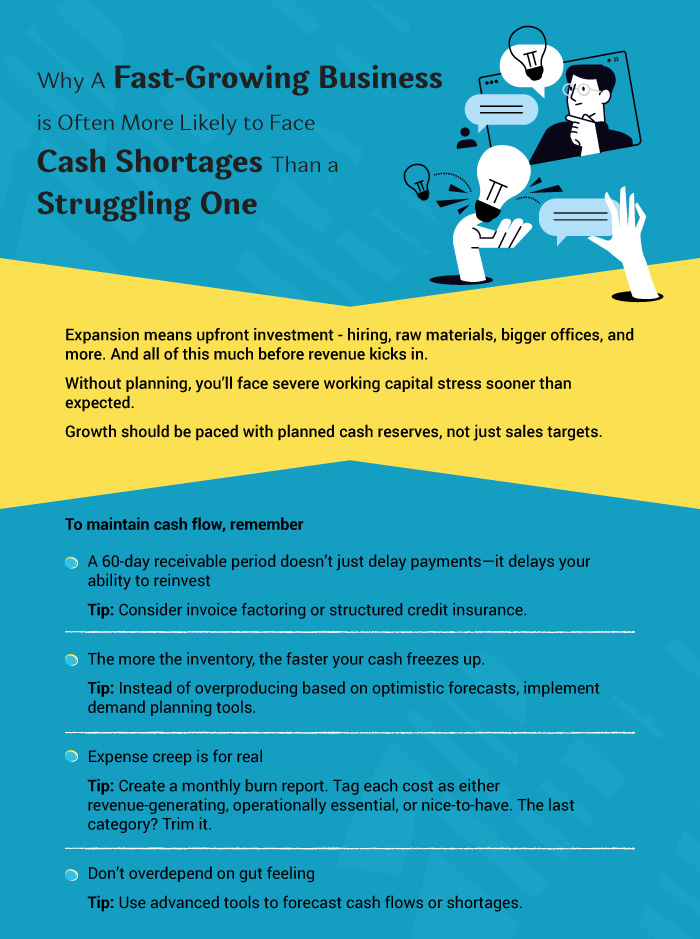Big Bazaar. Do you remember them? Once a retail giant in India, their parent company, Future Retail, filed for bankruptcy in 2022 after aggressive borrowing and a crushing debt pile. Talk about a fall from grace.
They’re not alone, either. The road to the top is littered with the remains of businesses long gone. Think of Jet Airways, Kingfisher Airlines, Educomp, even Byju’s. These booming businesses with strong demand—yet gone in a flash.
Why? Because profits don’t pay the bills. Cash does.
Take Housing.com, for example. Launched in 2012, it quickly became a startup star. But by 2017, after burning through cash on massive marketing spends and weak cash flow, it had to merge with PropTiger to stay afloat.
If this has you worried, let’s break down what went wrong and how you can avoid meeting the same fate as these once-great giants (and start-ups).
The problem
The bank balance does not reflect the success story. A thriving business means strong sales and even greater profit margins. On paper, everything can look picture-perfect!
But, as the month ends, expenses begin to accumulate, employees need to be paid, rent is due, and supplier invoices must be settled. You check your bank account and, to your dismay, realise that the balance sheet and the bank balance don't quite match up.
This is where the struggle begins, and it deepens when you assess pending payments from clients that are not yet due, given their credit terms of 30 or 60 days.
What just happened here?
If you haven't figured it out yet, the answer is a lack of cash.
Cash flow is the heartbeat of your business. Even the most profitable ventures need to maintain a surplus of cash or ensure that cash flow aligns with operational needs.
Common pitfalls
Here’s what a lot of businesses tend to face:
1. Delayed payments: When invoices are not paid within the given credit schedule, it can lead to significant problems. For example, if the credit period is 30 days but it’s already day 45 with no payment, your client’s cash flow problem has now become yours.
2. Overstocking: As your products began to leave the warehouse rapidly, you increased your production. However, during this time, orders may slow down, leading to overproduction. A large portion of your cash is now tied up in unsold inventory, essentially collecting dust.
3. Unchecked expenses: Increasing expenses on marketing, technology, and other areas may have seemed beneficial at first. However, these costs gradually accumulated, often unnoticed. Now, your situation is dire.
4. Long working capital cycles: You may have invested a significant amount in raw materials, production, and services, all from your funds. If payments are delayed, your reserves will quickly begin to diminish.
Why does it happen?
These problems occur because of poor planning or short-sightedness.
When a business starts to grow, there is palpable excitement all around. There are tons of leads, attractive conversions, expanding teams, increasing production, and onboarding new customers. So much is happening!
But while you may be spending now, it’s important to remember that earnings come in much later. Here are the mindsets you need to fix as a business owner to avoid the worse:
1. Chasing profit and growth over liquidity
As a business owner, your primary focus is understandably on sales, profits, and growth. However, it’s important to recognise that profits and numbers may look impressive on paper or a whiteboard, but they’re harder to replicate in real life.
If you do not have sufficient cash in the bank, this initial euphoria will be short-lived.
Why?
Because as the business grows, your team expands as well, and you must meet their corresponding salary obligations. Additionally, increased production means larger orders from vendors, necessitating timely payments for their invoices.
You also need a sizable amount of your budget to dedicate essentials like rent, electricity, water, and phone bills.
Even with impressive profits on paper, a lack of cash can lead to imminent disaster.
2. Poor cashflow management & forecasting
Most businesses, especially small businesses and startups, need to invest in proper forecasting tools.
These tools help you with accurate cash flow forecasting. This way, you can plan revenues and expenses and balance them out much before an adverse situation develops.
Remember to take the help of professional chartered accountants so that cash flow and cash timing sync seamlessly.
Many business owners and founders suffer from the ‘we’ll figure it out’ mindset. Even if you are prone to relying on your gut feeling, it is probably time to relook and reassess your approach.
If you’re running your business and planning for success, you need to use advanced tech tools and specialised expertise to make business decisions. Because in the end, your gut cannot pay bills, salaries, and GSTs.
Quick fixes to keep your cash flow flowing
Thankfully, there’s a way out. Cash flow problems can be fixed. Here are a few tips to do so:
1.Tighten up your receivables
Set realistic payment receiving schedules and follow up on invoices promptly. You can offer clients early payment discounts. Negotiate better payment terms, for example, by asking for 50% upfront payment.
Also Read: Mastering the Fine Art of Invoicing
2. Be smart with payables
The same rule applies to payables as receivables. Negotiate better terms with suppliers and vendors. Work out instalment options. Pay just before the due date to hold onto the cash for a longer period.
3. Track cash flow actively
Instead of using spreadsheets, shift to tools like TallyPrime for tracking cash flow. Reports generated by the tool are automated and accurate, depicting what’s coming in and going out.
4. Build an emergency buffer
This is one of the smartest ways to work. Maintain an emergency fund; ideally, two to three months' worth of operational expenses. This will help tide you over difficult times.

Conclusion
Here’s the cold, hard truth: No matter how great your product is, how happy your customers are, or how full your order book looks, if the cash isn’t flowing, the business won’t survive.
Profit on paper means little without real money in the bank. That’s why managing cash flow isn’t just important, it’s essential.
Start today. Try Smart Moves’ free Cash Flow Generator and take control of your finances. Explore our tools and templates designed to help you manage your business with ease and confidence!












